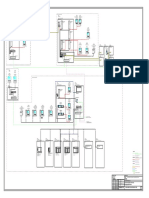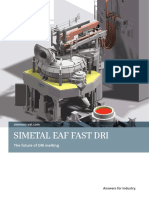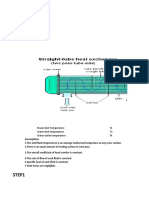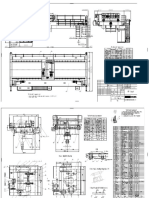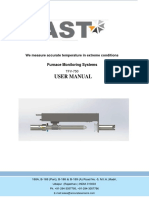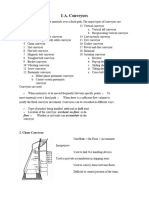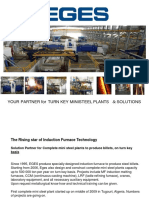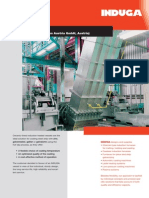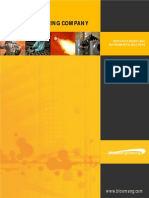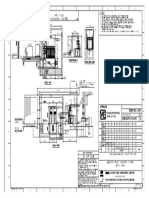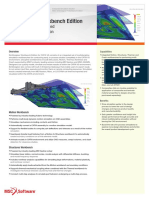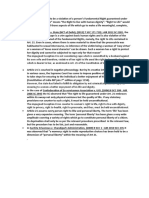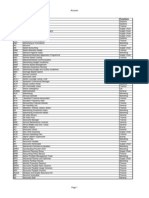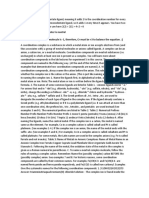04 - Control Method For Low Oxygen Concentration in Reheating Furnace PDF
04 - Control Method For Low Oxygen Concentration in Reheating Furnace PDF
Uploaded by
Văn Tuấn NguyễnCopyright:
Available Formats
04 - Control Method For Low Oxygen Concentration in Reheating Furnace PDF
04 - Control Method For Low Oxygen Concentration in Reheating Furnace PDF
Uploaded by
Văn Tuấn NguyễnOriginal Title
Copyright
Available Formats
Share this document
Did you find this document useful?
Is this content inappropriate?
Copyright:
Available Formats
04 - Control Method For Low Oxygen Concentration in Reheating Furnace PDF
04 - Control Method For Low Oxygen Concentration in Reheating Furnace PDF
Uploaded by
Văn Tuấn NguyễnCopyright:
Available Formats
20 Steel Technical Report, No.
24,Control
China pp. 20-Method
27, (2011)
for Low Oxygen Concentration in Reheating Furnace
Control Method for Low Oxygen Concentration in
Reheating Furnace
HENG-HSING CHENG, YUAN-LIANG HSU, CHAO-HUA WANG*,
FU-YUAN HSIA** and TUNG-TSAI OU**
Iron and Steel Research & Development Department
*New Materials Research & Development Department.
**Rolling Mill Department Ⅱ
China Steel Corporation
The reheating furnace consumes most of the energy and produces high amounts of carbon dioxide in the hot
rolling process. The oxygen concentration in the furnace atmosphere is very important because too much
oxygen will cause greater fuel consumption and will induce more scale on the slab surface and more nitrogen
oxides in the combustion gas. Proper control of the oxygen concentration enables the furnace to attain a bet-
ter production cost performance in energy consumption, slab scale loss and NOx emission. There are two
sources of oxygen in the furnace atmosphere. One is the combustion air supplied to the burner and the other
is the outside air infiltrated into the furnace during door opening. In this study, a control technology was
proposed to inhibit the air infiltration and to minimize the oxygen concentration in the furnace atmosphere
by controlling the furnace pressure and combustion air using a prediction method, which could estimate the
influence from the variation in combustion loading based on the state of change in the control loop. The pro-
posed control method has been implemented in the reheating furnaces of No.1 and No.2 hot strip mill in
China Steel Corporation. The results reveal that the control method could inhibit the air infiltration signifi-
cantly through a decrease in the furnace temperature drop after the door opening. Moreover, the oxygen
concentration in the furnace atmosphere could be stably minimized based on the better control performance.
Also, the results of experiments demonstrated that this method reduced the fuel consumption of the furnace,
the scale loss of the heated slab and thermal NOx emission.
Keywords: Furnace pressure, Oxygen concentration, Air-to-fuel ratio, Fuel consumption, Slab scale loss
1. INTRODUCTION essential element for the combustion reaction in the
reheating furnace, though the oxygen in the furnace
In the hot strip mill, slabs are heated above 1150C for
also participates in some of the reactions, including the
the subsequent rolling process, so the low-temperature
formation of nitrogen oxides (NOx), or oxide layer on
slabs are pushed into the reheating furnace from the
the surface of the slab (see Fig.2). Excess oxygen in the
charging side and heated gradually via the pre-heating
furnace not only increases the energy consumption and
zone, heating zone and soaking zone and extracted at
slab scale, but also increases the slab scale and thermal
the discharging door, as shown in Fig.1. Oxygen is an
NOx, and other negative effects suppressed during
Fig.1. Reheating furnace in hot strip mill.
Heng-Hsing Cheng, Yuan-Liang Hsu, Chao-Hua Wang, Fu-Yuan Hsia and Tung-Tsai Ou 21
oxygen deficiency. The best situation is to ensure the composition. For example, the coefficient for coke
complete combustion of the fuel under the premise of oven gas (C.O.G.), which is usually used as the source
minimizing the residual oxygen or, in other words, to of the heating fuel in the reheating furnace, is about
maintain a low level of oxygen concentration in the 4.2. The furnace temperature is controlled by adjusting
exhaust gas. On the other hand, in the high-temperature the fuel flow supplied to the burners and the air flow
furnace area, such as the heating zone and soaking needed for complete combustion according to the
zone, to supply deficient oxygen can effectively slow coefficient. However, it is difficult to control the
down the oxidation rate of steel slabs, so it is necessary composition of C.O.G. precisely. Figure 4 shows that
to ensure that all the residual fuel is burnt in the down- the calorific value of C.O.G. changes in the range of
stream zone. Fuel consumption and slab scale loss are 4080 to 4320 kcal/m3. If the fuel heating value changes,
the major costs in the hot rolled strip or plate the amount of air needed for combustion of fuel may be
production line in addition to the material cost. excessive or inadequate, resulting in a variation of the
Generally, in the reheating furnace the fuel oxygen concentration in the exhaust gas.
consumption per ton of steel is about 280 to 320×106
calories, and the oxide scale causes a slab weight loss
about 0.6 to 1%. Therefore, the stable control of the 4
concentration (%)
(%)
oxygen in the furnace atmosphere and the maintenance
concentration
of a low oxygen concentration in the exhaust gas are 3
the means to reduce fuel consumption and scale loss. 2
Oxygen
Combustion airair
Combustion 1
Oxygen
CO2 ,…
Discharge
Discharge
Slab discharging
Slab discharging
O2 door
door 0
0 10 20 30 40 50 60 70 80 90 100
NOx,… FeO,
FeO,… Time
Time (min)
(min)
Fig.3. Air inhalation during discharge door opening.
Air
Air
)
4400
3) 3
(kcal/m
Slab
Slab
value(kcal/m
4300
Fig.2. Reaction of oxygen in the slab reheating furnace.
calorific value
4200
There are two sources for the oxygen in the
COGcalorific
furnace atmosphere. One is the combustion air supplied 4100
to the burner and the other is the outside air inhaled
COG
into the furnace during the opening of the discharging 4000
0 10 20 30 40 50 60 70
door. Both result in a variation of the oxygen concen- Time (day)
Time (day)
tration in the furnace atmosphere. Every few minutes, Fig.4. Daily change of C.O.G calorific value.
the discharge door is opened briefly to extract the
heated slabs. Since there is a difference in the ambient In general, oxygen analyzers may be installed in
temperature inside and outside the furnace, there exists the roofs of the preheating zone, heating zone and
a vertical pressure drop. The vertical pressure drop soaking zone to measure the oxygen content in the fur-
causes negative pressure at the bottom of the furnace nace atmosphere and used to control the oxygen con-
while the door is opening and the outside air is inhaled centration of waste gas by automatically adjusting the
into the furnace. Therefore, the furnace temperature in air-to-fuel ratio (A/F ratio) in every zone(1-2). Some
the soaking zone is significantly decreased and the studies proposed other designs of oxygen feedback
oxygen concentration of the exhaust gas appears to control with time delay compensation(3) or used some
peak after the door is opened, as shown in Fig.3. advanced control techniques such as fuzzy-PID con-
Figure 3 also reveals that air inhalation is different each trol(4). However, in most furnaces of China Steel, the
time because of the different peak value of oxygen oxygen analyzer can easily fail in high temperature
concentration. surroundings such as those in the heating zone or soak-
Besides the air infiltration, the fluctuation of fuel ing zone and the sampling tube can easily become
composition also disturbs the oxygen concentration. clogged because of sulfide deposition. So the feedback
The unit volume of air required for complete control of oxygen concentration cannot be used in
combustion of fuel is called the theoretical air every furnace zone at China Steel. However, at higher
consumption coefficient and is based on the fuel temperatures, the oxidation rate of the slab in the fur-
22 Control Method for Low Oxygen Concentration in Reheating Furnace
nace may increase almost exponentially(5-6), so reducing with excess air, and finally a feedback control based on
the oxygen content in the high temperature zone can the actual oxygen concentration measured at the pre-
effectively reduce the slab scale as mentioned above. In heating zone roof near the charging door (a
practice, the combustion air supplied to the heating low-temperature area in the furnace, where the reliabil-
zone and soaking zone may be inadequately controlled ity of the oxygen analyzer is greatly enhanced) to cor-
by manually adjusting the A/F ratio less than 1.0 (with rect any error from the theoretical mode.
A/F ratio larger than 1.0 at the preheating zone). The proposed control method has been imple-
Therefore, the measured oxygen concentration at the mented in the reheating furnaces of No.1 and No.2 hot
heating zone and soaking zone would be zero and can- strip mills at China Steel Corporation. The results
not be used to control the A/F ratio automatically. Oth- reveal that the control method could inhibit the air
erwise, some studies proposed that real-time measuring infiltration significantly based on the decreasing of the
of the calorific value of C.O.G. to adjust the A/F ratio furnace temperature drop after the door opening. Addi-
dynamically in accordance with an empirical formula tionally, the oxygen concentration in the furnace atmos-
to compensate for the effect of changes in caloric phere could be stably minimized based on the better
value(7). However, this method is a kind of feed- control performance. Also, the results of experiments
forward control that is not able to overcome other demonstrate that this method improves the uniformity
disturbances such as air inhalation. of slab temperature and reduces the fuel consumption
Because there is no feasible and stable method for of the furnace, the scale loss of heated slab and thermal
oxygen control in the high furnace atmosphere, addi- NOx emission.
tional fuel consumption and scale loss result. In this
2. EXPERIMENTAL METHOD
research, a control method for low oxygen concentra-
tion of waste gas in a reheating furnace is proposed. The method proposed in this study for controlling
First, a discharge prediction control of the furnace the oxygen concentration in waste gas is exhibited in
pressure was developed to predict quantitatively the Fig.5. The method includes two parts: the discharge
level of air inhalation within a few seconds after the prediction control of the furnace pressure; and the
discharge door is opened. Then the furnace pressure automatic air-to-fuel ratio control with the estimation of
can be immediately controlled during the whole period the zone oxygen concentration.
of door opening (about 45 seconds) to reduce the air
2.1 Discharge Prediction Control of Furnace Pressure
inhaled into the furnace. Second, a new control archi-
tecture for automatically adjusting the A/F ratio was Because the transient response of the temperature
proposed to stably maintain the waste gas at a low field and flow field in the reheating furnace is complex
oxygen state. The new control architecture includes a when the discharge door is opened, it is difficult to
theoretical zone A/F ratio calculation by considering decouple the governing equation of furnace pressure by
the residual fuel gas or oxygen from the upstream zone, the theoretical analysis. Yet any change of the flow
the flow compensation when the burner is supplied field will eventually be reflected in changes of the
Oxygen
Oxygen concentration
concentration estimation
estimation
(Virtual
(Virtual sensor)
sensor)
-
+
Feedback
Feedback + Oxygen
Oxygen
Air-
Air-to-
to-fuel ratio
Air-to-fuel ratio control
control
modification
modification target
Target
-
Zone T-
T-F Zone T-
T-F Zone T-
T-F
cascade control cascade control cascade control
O2
Analyzer
- PHZ - - HZ - - SZ -
-
Damper + Pressure
Pressure
Pressure control target
Target
+
State
State estimation
estimation Prediction
Prediction control
control
Fig.5. Low oxygen control of reheating furnace.
Heng-Hsing Cheng, Yuan-Liang Hsu, Chao-Hua Wang, Fu-Yuan Hsia and Tung-Tsai Ou 23
equilibrium state of the furnace pressure control. After 0.5
Pressure control output change in 5s (%)
the study of large amounts of data through statistical
analysis the characteristics of the pressure changes 0
Pressure control output
during the opening of the discharge door were deter-
changein 55 (%)
-0.5
mined, as shown in Fig.6 and Fig.7. The temperature
drop at the soaking zone after discharging door is -1
opened can indicate the air inhalation as a quantitative -1.5
index. The data shown in Fig.6 reveals that the tem-
perature drop is quasi-linear relative to the average er- -2
ror of furnace pressure control during whole period of -2.5
0.05 0.1 0.15 0.2 0.25 0.3 0.35 0.4 0.45
discharging. Also, it was found that the trend of the Pressure control
Pressure error
control errorduring discharging
during discharging (mmH2O)
(mmH2O)
equilibrium state change in the furnace pressure control
is consistent throughout the whole period of discharg- Fig.7. Quasi-linear relation between pressure control er-
ror during discharging and control output change in 5s.
ing, so that the output change in the furnace pressure
control loop within 5 seconds after door opening has a
On the basis of the above-mentioned findings, the
negative correlation with the average error of pressure
discharging prediction control was designed in this
control, as shown in Fig.7. The control output was used
study to automatically adjust the furnace pressure. The
to adjust the flue damper opening.
control diagram is exhibited in Fig.8. Basically, the
furnace is kept at a low positive pressure, i.e. 0.2mm
H2O, and then starts to dynamically adjust the pressure
Pressure control error during discharging (mmH2O)
0.45
before the opening of the discharging door. Due to the
Pressure control error during
0.4
long distance from pressure measurement position to
discharging (mmH O)
0.35
the flue damper, the response of the furnace pressure
2
0.3
control is slow (about 10 seconds). So, about 30 sec-
0.25
onds before opening the door, the furnace pressure has
0.2
to be raised by following the pre-designed pattern. The
0.15
prediction control is then started 5 seconds after door
0.1 opening. The algorithm of the prediction control is to
0.05
-2 0 2 4 6 8 10
change a preset temperature drop in the expected fur-
T
SZ temperaturet d
drop
SZ temperature
(d
drop(deg)
)
(deg) nace pressure control error first, in accordance with the
linear regression equation in Fig.6. Then, the output
Fig.6. Quasi-linear relation between temperature drop at increment of the pressure PI controller (Proportional-
soaking zone and furnace pressure. control error during
discharging. Integral controller) within 5 seconds after each door
opening is used to estimate the average error of the
furnace pressure control during the whole discharging
Discharging prediction control
Discharging FPC ΔMV
error estimation calculation
Expected -
Expected + Gain
temperature
FPC error
drop
Action time-2 Trigger-1
+
Pressure + + Discharging Furnace
PID control Damper
target limitation
+ -
Action time-
1
Discharging pattern
Pressure sensor
FPC: Furnace pressure control loop
Discharge Trigger-1: 5sec after discharge door “OPEN”
door open Action time-1: from 5sec after discharge door “OPEN” to door “CLOSE”
Action time-2: from 30sec before discharge door “OPEN” to 20sec after door “CLOSE”
Fig.8. Discharging prediction control of furnace pressure.
24 Control Method for Low Oxygen Concentration in Reheating Furnace
period according to the linear regression equation in ~
i (Vf i Vf i 1 ) Va i 1
Fig.7. The difference between the estimated error and i .....................................(3)
~
the expected error can be used to adjust the control tar- Vf i
get of the furnace pressure directly until the discharging
V
door is closed. So, the correction of furnace pressure by f 0, Va ( i 1 1)Vf , if i 1 1 ............(4)
i1 i 1 i1
the prediction control is different and can control the 0, if 1
, V
Vf (1 I 1 )V i 1
air inhalation during each period of slab discharging. i1 f a i1 i 1
2.2 Automatic Air-to-Fuel Ratio Control In the final zone of the flow direction, all fuel gas
should be completely burnt to avoid any additional fuel
In general, the reheating furnace may be split into
consumption or pollution, so the control target in the
multiple independent temperature control zones to
preheating zone is the expected oxygen concentration
gradually heat slabs to a set temperature. The gas in the
( ) in the waste gas. The theoretical expression is
furnace flows from the soaking zone to the preheating
shown as Equation 5,
zone, so the residual fuel gas or air from the upstream
zone may influence the combustion reaction in the cur-
21 Va
rent zone, as shown in Fig.9. For example, if the sup- (%) PHZ
............................................(5)
plied air soaking zone is inadequate, i.e. the air-to-fuel V w Va
PHZ PHZ
(A/F) ratio of the soaking zone is set to 0.9, it means
that about 10% fuel gas may not be burnt and flow to where is V is the combustion gas in the preheating
w PHZ
its downstream zone (the heating zone.). The new con- zone and is expressed as Equation 6 according to the
trol method is based on the expected air-to-fuel ratio in theoretical combustion gas production coefficient ( )
every zone to re-calculate the required zone A/F ratio and then the expected air-to-fuel ratio can be calculated
by considering the residual fuel gas or air from the up- as Equation 7. Also, the required air-to-fuel ratio in the
stream zone. The algorithm is shown in Equation 1, preheating zone can be obtained by the Equation 3.
~ ~ ~
V w PHZ
(Vf PHZ
Vf Vf ) ............................ (6)
HZ SZ
Combustion air
~ ~ ~
(Vf Vf Vf )
Combustion Residual fuel or air PHZ ~
PHZ
1 ..................... (7)
HZ SZ
reaction form upstream zone (21 )(Vf Vf ) PHZ HZ
According to the above-mentioned algorithm the
Fig.9. Illustration of residual fuel gas or air form up- required A/F ratio in each zone can be calculated, so
stream zone. that the actual ratio of air and fuel gas participating in
the combustion reaction can meet the expected situa-
~ tion. Besides, additional air is required to ensure com-
V Va V
ai
~ i a i 1
i ..................................... (1) bustion efficiency when the fuel flow supplied to the (1
V burner is low. The additional air also affects the com-
fi Vf Vf i 1
i
bustion reaction in the downstream zone, so a compen-
are the volume flow of air and fuel gas
and V sation method was proposed to compensate for the
where V a i f i extra air from the burner. Finally, a feedback control
th
in the i zone; V and V are the residual air and
a i 1 f i 1 method was proposed to correct the error between the
~ ~ actual oxygen concentration measured in the preheating
fuel gas from the upstream zone; Va and Vf are the i i
zone and the estimated oxygen concentration. The
supplied air and fuel gas of the burner; i is the
estimated oxygen concentration is calculated by the
expected zone air-to-fuel ratio and η is the theoretical
measured flow rates of fuel gas and air in all combus-
air consumption coefficient of the fuel gas. ui is the
tion zones. It is assumed that any variation of the calo-
required air-to-fuel ratio for controlling the supplied air
rific value of C.O.G. results in a percentage change
of burner as shown in Equation 2 and it can be
of the theoretical air consumption coefficient
expressed as Equation 3, where the residual air or fuel
( (1 ) ). Substituting into Equation 5, the
gas are calculated as Equation 4.
measured oxygen concentration ( ~ ) can be expressed
~ ~
.......................................................... (2) as Equation 8. Therefore, the percentage change of the
Vai iVfi
theoretical air consumption coefficient can be estimated
as Equation 9 and used to correct the theoretical zone
Heng-Hsing Cheng, Yuan-Liang Hsu, Chao-Hua Wang, Fu-Yuan Hsia and Tung-Tsai Ou 25
air-to-fuel ratio and flow compensation via a PI 1180
(deg)
Slab discharging
controller. Figure 10 depicts the brief control diagram
(deg)
1170
of the automatic A/F control. To reduce the influence of
SZ temperature
SZ temperature
any time delay from the flow field and measurement 1160
response, all data used in the feedback correction was
1150
calculated via a window average with the duration of 5
minutes. 1140
0 10 20 30 40 50
Time(min)
Time (min)
(a)(a)
~ ~ ~ ~ ~ ~ 1180
~ (%) 21 [(Va Va Va ) (1 )(Vf Vf Vf )]
(deg)
PHZ HZ SZ PHZ HZ SZ
~ ~ ~ ~ ~ ~ ~ ~ ~ Slab discharging
(deg)
(Vf PHZ
Vf Vf ) [(Va Va Va ) (1 )(Vf Vf Vf )]
HZ SZ PHZ HZ SZ PHZ HZ SZ 1170
SZ temperature
SZ temperature
................................... (8) 1160
1150
~ ~ ~ ~ ~ ~ ~ ~ ~
(21 ~ ) [(Va Va Va ) (Vf Vf Vf )] ~ ( Vf Vf Vf ) 1140
PHZ HZ SZ PHZ HZ SZ PHZ HZ SZ 0 10 20 30 40 50
~ ~ ~ ~ ~
((21 ) ) (V V V ) f PHZ f HZ f SZ
Time (min)
Time (min)
(b)
(b)
..................................... (9) Fig.11. Results of soaking zone temperature (a)without
and (b)with discharging prediction control of furnace
pressure.
3. RESULTS AND DISCUSSION
4
concentration(%)
(%)
The discharging prediction control can predict the
concentriation
3
level of air inhalation after the opening of the dis- Slab discharging
charging door and automatically adjust the furnace 2
pressure. Figure 11 shows the results of the discharging 1
Oxygen
prediction control. The Figure11(a) shows the phe-
Oxygen
0
nomenon of temperature drop at the soaking zone after 0 10 20
Time
30 40 50
Time(min)
(min)
slab discharging without using the prediction control. (a)
(a)
The temperature drop after each slab discharging is
(%)
4
concentration (%)
different means that the level of air inhalation is also
concentriation
different. The Figure11(b) reveals that the temperature 3
drop is significantly improved by using the prediction 2
Slab discharging
control. The measured oxygen concentration in the 1
Oxygen
waste gas shown in Fig.12 also demonstrates that the
Oxygen
0
air inhalation from the discharging door is decreased. 0 10 20 30 40 50
Time(min)
Time (min)
(b)
(b)
Fig.12. Results of oxygen concentration (a)without and
(b)with discharging prediction control of furnace pressure.
Fuel flow Fuel flow
O2 to zone
control
estimation Zone
1 temperature
Air flow Air flow
+ control X X
+ control to zone
+ 1+Δ
X
Low fuel bias +
A/F ratio target (=4.2)
+ Window △ PI Zone A/F ratio + +
average estimation control calculation
- -Window length: 5min -Dead band: ±0.015 + +
-Limit: ±0.07
Flow
O2 measured at compensation
preheating zone
X
Fig.10. Automatic A/F ratio control at low oxygen concentration.
26 Control Method for Low Oxygen Concentration in Reheating Furnace
Figure 13 shows the statistical results of the pre- shows the result of low oxygen control. The measured
diction control in a long-term demonstration. The peak oxygen concentration is more stable and has a signifi-
of measured oxygen concentration and the amount of cantly small standard deviation, enabling the furnace to
temperature drop are both indices for quantifying the remain at a stable low oxygen state. Figure 15 exhibits
air inhalation during door opening. Although there is no the statistical results of long-term testing in the four
method to measure the air inhalation directly, the posi- reheating furnaces of No.1 hot strip mill. The results of
tive correlation shown in Fig.13(a) reveals that the two the trials with low oxygen control all show smaller
quantitative indices are related to the air inhalation. mean values and standard deviations in oxygen con-
After using the prediction control, both the averages and centration. The trials also demonstrate that the pro-
standard deviations in the two indices are decreased posed control method is feasible even when the new
as shown in Fig.13(b). Also, the lower standard devia- control used in different furnace.
tion in the two indices means that the prediction control 5
(%) (%)
Mean±std. = 1.08±
1.08±0.55%
indeed inhibits the air inhaled into the furnace every 4
concentration
time the discharging door is opened.
concentriation
3
4
Mean±3xstd.
= 1.71±3x0.49 2
OxygenOxygen
(%)
peak (%)
3 1
concentration peak
0
Oxygenconcentriation
0 10 20 30 40 50
2
Time (hour)
Time (hour)
(a)
5
1
(%) (%)
Mean±std. = 0.52±
0.52±0.33%
Mean± 3xstd. 4
Oxygen
concentration
= 21.88 ± 3x4.18
0
concentriation
0 10 20 30 40 2
OxygenOxygen
SZ
SZtemperature
temperature drop
drop (deg)
(deg)
(a)
(a) 1
4
0
0 10 20 30 40 50
Oxygen concentriation peak (%)
Oxygen concentration peak (%)
Time (hour)
Time (hour)
3
(b)
(b)
Mean±3xstd. Fig.14. Results of oxygen concentration (a)without and
2
= 0.32±3x0.22 (b)with low oxygen control.
No.1 Furnace No.2 Furnace
Without LOC Without LOC
1 3 With LOC With LOC
(%)concentration (%)
Mean± 3xstd.
0 = 7.18 ± 3x2.79 2
0 10 20 30 40
Oxygen
SZ
SZ temperature drop (deg)
temperature drop (deg) 1
(b)
Oxygen concentriation
(b)
Fig.13. Statistical results of temperature drop and oxy-
0
gen peak (a)without and (b)with discharging prediction Trial-1 Trial-2 Trial-3 Trial-4 Trial-1 Trial-2 Trial-3 Trial-4
control of furnace pressure. No.3 Furnace No.4 Furnace
Without LOC Without LOC
Figure 14(a) shows the measured oxygen concen- With LOC With LOC
tration of waste gas before using the low oxygen con-
trol. All A/F ratios in the preheating zone, heating zone
and soaking zone are fixed, so that any change of fuel
heat value or other disturbance may induce a variance
of oxygen concentration. Therefore, the A/F ratios were
set higher than formerly to ensure the complete com-
bustion of the supplied fuel. However, this inevitably Trial-1 Trial-2 Trial-3 Trial-4 Trial-1 Trial-2 Trial-3 Trial-4
results in an excess of supplied air and causes addi- Fig.15. Statistical results of low oxygen control in dif-
tional fuel consumption and scale loss. Figure 14(b) ferent furnaces.
Heng-Hsing Cheng, Yuan-Liang Hsu, Chao-Hua Wang, Fu-Yuan Hsia and Tung-Tsai Ou 27
Table 1 Benefits of low oxygen control at China Steel
Fuel consumption Scale loss
No.1 Hot Strip Mill No.1 Furnace 3.068% 0.0538%
No.2 Furnace -0.241% 0.0422%
No.3 Furnace 1.218% 0.0541%
No.4 Furnace 0.498% 0.0199%
No.2 Hot Strip Mill No.1 Furnace 1.575% 0.0086%
No.2 Furnace 1.633% 0.0140%
Average 1.292% 0.0321%
To increase the controllability of oxygen content in the other is the outside air infiltrated into the furnace
a furnace atmosphere, the proposed control method in during the discharge door opening. Also, the infiltration
this study first inhibits the air inhalation from the dis- of cold air will lead to an inconsistent temperature
charging door by using prediction control, and then decreasing rate on both sides of the slab and cause a
automatically controls the A/F ratio in each combustion non-uniformity of slab temperature. In this study, a
zone via zone A/F calculation, flow compensation and control technology was proposed to inhibit the air infil-
feedback correction. It is important that in the feedback tration and to minimize the oxygen concentration in the
control loop, the control target is not the expected oxy- furnace atmosphere by controlling the furnace pressure
gen concentration. The control target is the estimated and combustion air with a prediction method, which
oxygen concentration calculated according to the could estimate the influence of the variation of com-
measured flow of supplied fuel and air. And, the results bustion loading based on the state change in the control
demonstrate that this kind of control method is useful loop. The proposed control method has been imple-
to control the oxygen content. mented in the reheating furnaces of No.1 and No.2 hot
The proposed control method for controlling the strip mills at China Steel Corporation. The results
oxygen content in a furnace atmosphere has been revealed that the control method could significantly
implemented in the reheating furnaces of No.1 and inhibit the air infiltration after door opening. Moreover,
No.2 hot strip mills at China Steel Corporation. After a the oxygen concentration in the furnace atmosphere
total of six furnace testing trials (the results are indi- could be stably minimized by the better control per-
cated in Table 1), it is demonstrated that using the con- formance. Also, the results of experiments demon-
trol method can have the benefits of saving 1.292% in strated that this method could improve the uniformity
fuel consumption and increasing the yield by 0.0321%. of slab temperature and reduce the furnace fuel con-
In other words, when this low oxygen control method is sumption, the scale loss of heated slab, and the thermal
used in the two hot strip mills it is able to annually save NOx emission.
about 7.9×106 m3 of C.O.G. consumption, reduce about
REFERENCES
2,000 tons of slab scale loss and decrease about 6,000
tons of CO2 emissions. 1. L.-J. Jiang, J.-G. Jiang, T. Fu, and Y.-J. Yang:
Shandong Metallurgy; 2006, vol. 28, no. 2, pp.
4. CONCLUSIONS
24-26.
In the reheating furnace of a hot rolling mill, ther- 2. H.-Q. Bai: Journal of Astronautic Metrology and
mal energy from fuel combustion heats the slab via Measurement; 2003, vol. 23, no. 4, pp. 57-62.
heat transfer of radiation and convection. Therefore, the 3. X.-Y. Liu, J. Sun, and X.-Y. Li: Techniques of
furnace consumes most of the energy and produces Automation & Applications; 2005, vol. 24, no. 9,
high amounts of carbon dioxide in the hot rolling proc- pp. 75-77.
ess. The oxygen concentration in the furnace atmos- 4. X.-Y. Liu, J.-D. Zhang, and X.-Y. Li: Control Sys-
phere is very important because too much oxygen will tems; 2006, vol. 22, no. 1-1, pp. 39-40.
cause more fuel consumption and will induce more 5. Z.-Z. Liu, Z.-P. Zheng, C.-J. Ding, H.-S. Zeng, and
scale on the slab surface and more nitrogen oxides in D.-M. Zhang: Energy for Metallurgical Industry;
the combustion gas. Proper control of the oxygen con- 2004, vol. 23, no. 2, pp. 30-32.
centration can enable the furnace to obtain a better 6. T.-B. Wei: Research on Iron & Steel; 2003, no. 4,
performance in terms of production cost in energy pp. 54-58.
consumption, slab scale loss, and NOx emission. There 7. S.-M. Tao: Baosteel Technology; 2003, no. 3, pp.
are two sources of oxygen in the furnace atmosphere. 38-42. □
One is the combustion air supplied to the burner and
You might also like
- John E. Peterson - Isometric Power Revolution (2007)Document292 pagesJohn E. Peterson - Isometric Power Revolution (2007)Miguel Angel Torres Spezzia92% (63)
- Siemens Mammomat Balance Planning GuideDocument20 pagesSiemens Mammomat Balance Planning GuideMarlon DeteraNo ratings yet
- Info Fivesstein Missing: TrackballDocument2 pagesInfo Fivesstein Missing: TrackballSaurabh BhandariNo ratings yet
- Publication: Billet Homogenizing - Batch or Continuous?Document11 pagesPublication: Billet Homogenizing - Batch or Continuous?조기현No ratings yet
- ISOTEX OA R2 - VX-BF-1000 (Rice Husk) 14-03-2023Document17 pagesISOTEX OA R2 - VX-BF-1000 (Rice Husk) 14-03-2023atul guptaNo ratings yet
- Damper Valve Cmovalves Serie MF Rev 00 Sheet Data enDocument17 pagesDamper Valve Cmovalves Serie MF Rev 00 Sheet Data enGuillaume de PluviéNo ratings yet
- Technology of Fuel-Fired Melting Furnaces at Otto JunkerDocument4 pagesTechnology of Fuel-Fired Melting Furnaces at Otto JunkerArsNo ratings yet
- 000-000-550-184 00 H015-DAN-CSMA-H&T-M-ASM-037 00: Segment 0 Roll Lifting 150 Segment A Idle Roll Lifting 220Document1 page000-000-550-184 00 H015-DAN-CSMA-H&T-M-ASM-037 00: Segment 0 Roll Lifting 150 Segment A Idle Roll Lifting 220rajitkumar.3005No ratings yet
- HJ1 - 2K31 - 3007 - 7 - (ASB) Drawing For Loading Platform Page 59Document1 pageHJ1 - 2K31 - 3007 - 7 - (ASB) Drawing For Loading Platform Page 59Vu Hoang AnhNo ratings yet
- Manufacturing Instructions SN 200-6: Assembly/installation and DismantlingDocument7 pagesManufacturing Instructions SN 200-6: Assembly/installation and DismantlingLinh LạiNo ratings yet
- PhoenixTM Brochure HTS07 V11 UK EmailDocument4 pagesPhoenixTM Brochure HTS07 V11 UK EmailOnline EmenuNo ratings yet
- Simetal Eaf Fast Dri enDocument6 pagesSimetal Eaf Fast Dri enAgustine SetiawanNo ratings yet
- New Heat Exchaner Design - 5mwDocument13 pagesNew Heat Exchaner Design - 5mwSteve WanNo ratings yet
- Installation Manual: ASIC/1-8655Document36 pagesInstallation Manual: ASIC/1-8655DondonNo ratings yet
- SMS Group Newsletter 2019-1 ENDocument154 pagesSMS Group Newsletter 2019-1 ENJason SengNo ratings yet
- RT650 ManualDocument146 pagesRT650 ManualGraciela SobradoNo ratings yet
- Isometric View F G (1:5) Typ.: Welds As Per Danieli STD 2.8.006Document1 pageIsometric View F G (1:5) Typ.: Welds As Per Danieli STD 2.8.006rajitkumar.3005No ratings yet
- 3 - 120301 - PreambleDocument8 pages3 - 120301 - PreambleJesus E. Escamilla EstradaNo ratings yet
- DESIGN Shape Dimension (Tyrolit GW)Document7 pagesDESIGN Shape Dimension (Tyrolit GW)X800XLNo ratings yet
- 翻译半18080579-580 QD20T-21.5M-20M A6circuit diagram-Model2 - 合并Document19 pages翻译半18080579-580 QD20T-21.5M-20M A6circuit diagram-Model2 - 合并Imran Ullah KhanNo ratings yet
- A STD 2.8.006 CLASS: Welds As Per DanieliDocument1 pageA STD 2.8.006 CLASS: Welds As Per Danielirajitkumar.3005No ratings yet
- 001 00 PDFDocument1 page001 00 PDFGerman GomezNo ratings yet
- Numerical Heat TransferDocument1,183 pagesNumerical Heat TransferMohammed TahaNo ratings yet
- Tds Fire Clay Brick Sk30 enDocument1 pageTds Fire Clay Brick Sk30 enjcljeNo ratings yet
- Handling of Rebar Bundles: A One-Man OperationDocument3 pagesHandling of Rebar Bundles: A One-Man Operationrazen_inNo ratings yet
- 14 Joachim Von Scheele LindeDocument27 pages14 Joachim Von Scheele LindeМихаил ПолковниковNo ratings yet
- 40 Mva Technical SpecificationDocument29 pages40 Mva Technical Specificationabhishek srivastavNo ratings yet
- Automation Engineers, RaipurDocument31 pagesAutomation Engineers, Raipurkar_simNo ratings yet
- TFV - 750 Manual OriginalDocument35 pagesTFV - 750 Manual OriginalJohn SafeerNo ratings yet
- Circumferential Seam L.S. Longitudinal Seam L.S.H. Longitudinal Seam HeadDocument1 pageCircumferential Seam L.S. Longitudinal Seam L.S.H. Longitudinal Seam HeadSonNguyenNo ratings yet
- Catalogo Honeywell PDFDocument176 pagesCatalogo Honeywell PDFKarl WeierstrassNo ratings yet
- XXXX Evacuation Area ESDocument45 pagesXXXX Evacuation Area ESRifatAlAhmedNo ratings yet
- 8 Material Handling - EquipmentDocument40 pages8 Material Handling - EquipmentmhenimmangaNo ratings yet
- Section 5.2: Motor List Annealing FurnaceDocument2 pagesSection 5.2: Motor List Annealing FurnaceNguyễn ChâuNo ratings yet
- Fresh Air Flap: Machine Manual En-21017.831-FDocument21 pagesFresh Air Flap: Machine Manual En-21017.831-FRahmat YusufNo ratings yet
- Calculate Available Heat PDFDocument14 pagesCalculate Available Heat PDFjeas grejoy andrewsNo ratings yet
- Heat Treatment Proposal (Group #2)Document5 pagesHeat Treatment Proposal (Group #2)Emilio E Mayorga TapiaNo ratings yet
- 8303344R 001-TrspDocument1 page8303344R 001-TrspSonNguyenNo ratings yet
- 28 01 12 Eges Mini Steel PlantDocument21 pages28 01 12 Eges Mini Steel PlantElafanNo ratings yet
- ALUMINIUMTECHNOLOGIES Week10Document110 pagesALUMINIUMTECHNOLOGIES Week10NhocSkyzNo ratings yet
- Shimadzu TOC-L Series Combustion Tube For High Salt Samples Instruction ManualDocument76 pagesShimadzu TOC-L Series Combustion Tube For High Salt Samples Instruction ManualMuhammad RohmanNo ratings yet
- Strip Galvanizing PotDocument2 pagesStrip Galvanizing Potsp_1975No ratings yet
- General Arrangement For Platform & Ladder Acf Condensate Carbon Filter PackageDocument5 pagesGeneral Arrangement For Platform & Ladder Acf Condensate Carbon Filter PackageSonNguyenNo ratings yet
- SMS Group - Full Liner in Superior Submerged ArcDocument126 pagesSMS Group - Full Liner in Superior Submerged ArcmaburaNo ratings yet
- Fce Speaking Sample Paper 1996 5 PDFDocument5 pagesFce Speaking Sample Paper 1996 5 PDFCurtis GautschiNo ratings yet
- Gas Train Requirements For Gas or Dual Fired Steam Boiler PDFDocument2 pagesGas Train Requirements For Gas or Dual Fired Steam Boiler PDFringo limNo ratings yet
- Foundation Load (Reactions) Data FOR 45 M Diameter ThickenerDocument88 pagesFoundation Load (Reactions) Data FOR 45 M Diameter ThickenerARAFANo ratings yet
- Transmittal # - AQS-DAN-SUB-0005 - Rev.00Document2 pagesTransmittal # - AQS-DAN-SUB-0005 - Rev.00AchRaf OudjertniNo ratings yet
- Bloom Engineering Overview BrochureDocument10 pagesBloom Engineering Overview BrochureEhab MassoudNo ratings yet
- Southwire Shaft FurnaceDocument2 pagesSouthwire Shaft FurnaceГеоргий Романов100% (1)
- 翻译半18080577-578 QDY40-15T-20.5M A7 circuit diagram-Model99 - 合并Document26 pages翻译半18080577-578 QDY40-15T-20.5M A7 circuit diagram-Model99 - 合并Imran Ullah KhanNo ratings yet
- Heat TransmissionDocument24 pagesHeat Transmissionespinosa_mra978No ratings yet
- 20 LinconDocument119 pages20 LinconsundyaNo ratings yet
- Item 22: Blast Furnace/Proper BMM Blast Furnace ComplexDocument1 pageItem 22: Blast Furnace/Proper BMM Blast Furnace ComplexSABYASACHI SAMANTANo ratings yet
- Outlet Apparatus: Machine Manual En-23122.102-ADocument16 pagesOutlet Apparatus: Machine Manual En-23122.102-ARahmat YusufNo ratings yet
- FurnXpert Presentation Reheat Batch DemoDocument23 pagesFurnXpert Presentation Reheat Batch Demodarwin_huaNo ratings yet
- CVS Superflexible EafDocument43 pagesCVS Superflexible Eafmetudgn100% (1)
- 08 - Thermal InsulationDocument13 pages08 - Thermal InsulationFlorian_AngererNo ratings yet
- Irizar Forge Product Guide 2021 METRICDocument92 pagesIrizar Forge Product Guide 2021 METRICjuniorex773No ratings yet
- 1 Final Drawings For Furance Layout SHT No 2Document1 page1 Final Drawings For Furance Layout SHT No 2Basavaraj M PatilNo ratings yet
- Uaq c1 w0 Eri 5010 MH WRF 001 Reva - Erd Technical FileDocument20 pagesUaq c1 w0 Eri 5010 MH WRF 001 Reva - Erd Technical FileABHIJITH M SNo ratings yet
- 1 s2.0 S1743967117307869 MainDocument13 pages1 s2.0 S1743967117307869 Maindigitalginga2No ratings yet
- V1 1 CompleteDocument283 pagesV1 1 CompleteVăn Tuấn NguyễnNo ratings yet
- Hydrofoil Seaplane DesignDocument139 pagesHydrofoil Seaplane DesignVăn Tuấn NguyễnNo ratings yet
- Stress Analysis and Weight Reduction of Roller of Roller ConveyorDocument7 pagesStress Analysis and Weight Reduction of Roller of Roller ConveyorVăn Tuấn NguyễnNo ratings yet
- Catalog Tham KhảoDocument9 pagesCatalog Tham KhảoVăn Tuấn NguyễnNo ratings yet
- CFD Analysis of A Three Bladed H-Rotor oDocument12 pagesCFD Analysis of A Three Bladed H-Rotor oVăn Tuấn NguyễnNo ratings yet
- Process & Gas Solutions: Centrifugal Air & Gas CompressorsDocument10 pagesProcess & Gas Solutions: Centrifugal Air & Gas CompressorsVăn Tuấn NguyễnNo ratings yet
- Chapter13 EnergyfromMicroalgaeDocument21 pagesChapter13 EnergyfromMicroalgaeVăn Tuấn NguyễnNo ratings yet
- Simdesigner Workbench Edition: All-In-One Cad-Embedded Multidiscipline SimulationDocument2 pagesSimdesigner Workbench Edition: All-In-One Cad-Embedded Multidiscipline SimulationVăn Tuấn NguyễnNo ratings yet
- EDU CAT EN V5A FF V5R19 Lesson06 ToprintDocument75 pagesEDU CAT EN V5A FF V5R19 Lesson06 ToprintVăn Tuấn NguyễnNo ratings yet
- MVR (Mechanical Vapour Recompression) Systems For Evaporation, Distillation and DryingDocument12 pagesMVR (Mechanical Vapour Recompression) Systems For Evaporation, Distillation and DryingVăn Tuấn Nguyễn100% (2)
- ANSYS Discovery Live: Instantaneous Simulation Technology Preview Available ForDocument2 pagesANSYS Discovery Live: Instantaneous Simulation Technology Preview Available ForVăn Tuấn NguyễnNo ratings yet
- Ansys Discovery Live: Real-Time Simulation RevolutionDocument4 pagesAnsys Discovery Live: Real-Time Simulation RevolutionVăn Tuấn Nguyễn0% (1)
- Hydrogen Permeation - Hydrogen Applications Solution NotesDocument4 pagesHydrogen Permeation - Hydrogen Applications Solution NotesAid Farhan Maarof100% (1)
- Abstract - Doctor Appointment PDFDocument3 pagesAbstract - Doctor Appointment PDFJansiNo ratings yet
- Module 6Document3 pagesModule 6EJ Santos100% (1)
- Tragic AsteroidsDocument13 pagesTragic AsteroidsRaymond Nolan ScottNo ratings yet
- Article 21 Ccontentions and CasesDocument1 pageArticle 21 Ccontentions and CasesSakshi mishraNo ratings yet
- Pulsar45 OpmanualDocument28 pagesPulsar45 OpmanualNilson HurtadoNo ratings yet
- Glossary of AbbreviationsDocument19 pagesGlossary of AbbreviationsNatalia Gonta0% (1)
- Shwetark GanpatiDocument3 pagesShwetark GanpatiPt AkaashNo ratings yet
- 3A Steam Jet Heaters BrochureDocument16 pages3A Steam Jet Heaters Brochurealfonso salamanca echeverriNo ratings yet
- MSDS - SteviaDocument5 pagesMSDS - SteviaAlyssa DuenasNo ratings yet
- DominosDocument13 pagesDominosSasmita HembramNo ratings yet
- ServicesDocument18 pagesServicesNoor AfshanNo ratings yet
- Perlindungan Dan Pengelolaan Lingkungan HidupDocument27 pagesPerlindungan Dan Pengelolaan Lingkungan HidupAndreas AldyNo ratings yet
- Medical BillDocument2 pagesMedical Billsudhanshuanjali1No ratings yet
- Detailed Lesson Plan in Science 12 2Document8 pagesDetailed Lesson Plan in Science 12 2Rizza Mae Telebrico CantereNo ratings yet
- Oxalate (C2O4) Is - 2 and Water Is Neutral The Overall Charge of The Molecule Is - 1, Therefore, CR Must Be +3 To Balance The Equation.:)Document2 pagesOxalate (C2O4) Is - 2 and Water Is Neutral The Overall Charge of The Molecule Is - 1, Therefore, CR Must Be +3 To Balance The Equation.:)Roberto PichardoNo ratings yet
- Sika - Waterbars: PVC Profile Waterstops For Joint SealingDocument5 pagesSika - Waterbars: PVC Profile Waterstops For Joint SealingKwok MorrisNo ratings yet
- Stock 09 OktoberDocument28 pagesStock 09 OktoberGigih Kenanga SariNo ratings yet
- Broiler ProductionDocument13 pagesBroiler ProductionAlexa Khrystal Eve Gorgod100% (1)
- Module 3 FP Client AssessmentDocument54 pagesModule 3 FP Client AssessmentJhunna TalanganNo ratings yet
- Management MCQSDocument5 pagesManagement MCQSWillis ITNo ratings yet
- PROSEDUR Perawatan Submarine HoseDocument5 pagesPROSEDUR Perawatan Submarine HoseTaufik ismailNo ratings yet
- Noe Valley Commode BudgetDocument1 pageNoe Valley Commode BudgetJoe EskenaziNo ratings yet
- The Analysis and Forecasting COVID-19 Cases in The United States Using Bayesian Structural Time Series ModelsDocument16 pagesThe Analysis and Forecasting COVID-19 Cases in The United States Using Bayesian Structural Time Series ModelsClaudyaNo ratings yet
- New ResumeDocument2 pagesNew Resumeapi-312448147No ratings yet
- Polyurea Grease Mobil SHC PolyrexDocument2 pagesPolyurea Grease Mobil SHC PolyrextribolasNo ratings yet
- Manual IMEXUS 28Document35 pagesManual IMEXUS 28polidorosNo ratings yet
- Ad226 LeafletDocument4 pagesAd226 LeafletSanti YuliandariNo ratings yet


